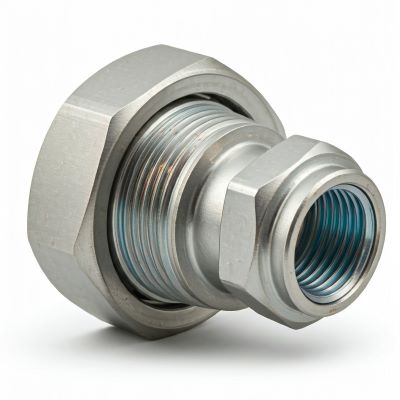Many sectors rely on hydraulic systems to power everything from delicate precision equipment to large machines. At the heart of these systems lies a network of hoses and fittings, working tirelessly to transfer fluid power.
But what often goes unnoticed is the crucial role of hydraulic hose fittings, particularly the 1 1/4 size, in ensuring the durability and longevity of the entire system.
What Are 1 1/4 Hydraulic Hose Fittings?
Connecting hoses to different hydraulic components, such as pumps, valves, and cylinders, requires 1 1/4 hydraulic hose fittings. They come in a variety of styles, including straight, elbow, tee, and swivel fittings, each designed for specific applications.
The 1 1/4 size refers to the nominal inside diameter of the fitting, which is crucial for ensuring proper fluid flow and system pressure.
The Role of 1 1/4 Hydraulic Hose Fittings in Maintaining System Integrity
Hydraulic hose fittings play a pivotal role in maintaining system integrity by:
➡️ Preventing Leaks: A well-fitted and properly installed fitting ensures a tight seal, preventing fluid leaks that can lead to system inefficiency, safety hazards, and costly downtime.
➡️ Enhancing Fluid Transfer Efficiency: The right fitting size and design optimize fluid flow, maximizing the system’s performance and reducing energy consumption.
➡️ Minimizing Wear and Tear on Hoses: Proper fitting installation and maintenance reduce stress on hoses, extending their lifespan and preventing premature failure.
Material Matters: Choosing the Right Fitting for Maximum Durability
The material of a hydraulic hose fitting significantly impacts its durability and performance. Common materials include:
➡️ Steel: A durable and cost-effective option, often used in general-purpose applications.
➡️ Stainless Steel: Highly corrosion-resistant, making it ideal for harsh environments and applications involving corrosive fluids.
➡️ Brass: Provides good corrosion resistance and machinability, commonly used in low-pressure applications.
Pressure Ratings and Load-Bearing Capacity: Ensuring Long-Lasting Performance
1 1/4 hydraulic hose fittings are designed to handle specific pressure ratings. It’s essential to select fittings that can withstand the maximum pressure your system will experience. Overloading fittings can lead to catastrophic failure, causing damage to equipment and potential injury.
How Proper Installation Impacts Fitting Durability
Proper installation is crucial for the long-term durability of hydraulic hose fittings. Key factors to consider include:
➡️ Cleanliness: Ensuring that the fitting and hose surfaces are clean and free of debris prevents contamination and ensures a tight seal.
➡️ Tightening Torque: Over-tightening or under-tightening can damage the fitting or cause leaks. It’s crucial to adhere to the torque recommendations stated by the manufacturer.
➡️ Avoid Kinking or Bending Hoses: Excessive stress on hoses can lead to premature failure. Proper routing and support are necessary to prevent kinking or bending.
Signs of Wear and Tear in 1 1/4 Hydraulic Hose Fittings
Regular inspection of hydraulic hose fittings can help identify potential issues before they escalate. Signs of wear and tear include:
➡️ Corrosion: Rust or pitting on the fitting’s surface can weaken the material and lead to leaks.
➡️ Cracks or Damage: Physical damage to the fitting can compromise its structural integrity.
➡️ Fluid Leakage: Even minor leaks can indicate a problem with the fitting or hose.
Check out these other resources ⬇️⬇️⬇️
How to Pick the Perfect Hydraulic Quick Coupler Types
A Guide to Hydraulic Hose Connection Types for Every Need
Upgrading Your System: When and Why to Replace Old Hydraulic Hose Fittings
As hydraulic systems age, it’s essential to assess the condition of the fittings. If you notice signs of wear or if the system is experiencing frequent failures, it may be time for an upgrade. Replacing old fittings with high-quality 1 1/4 hydraulic hose fittings can significantly improve system performance, reliability, and safety.
Conclusion: Investing in Durability for Long-Term Success
By understanding the importance of 1 1/4 hydraulic hose fittings and taking proactive steps to maintain and replace them, you can ensure the long-term durability and efficiency of your hydraulic system.
Investing in high-quality fittings is not just a cost; it’s an investment in the future of your operations.
Post time: Oct-23-2024


